When I come across two step word problems, I ask my students, “Anyone notice anything special about this problem?” Then they answer back saying, “It’s not a one step problem… It’s a two step word problem!”
Two step word problems can be tricky for students at any age. It involves reasoning where students need to figure out if they should add or subtract. There are more numbers involved so they can’t just guess. But after teaching 2nd grade for years, I’ve learned what I can do to support students with two step word problems. Soon they aren’t tricky anymore. Students can always know when they should add and subtract to solve the problems.
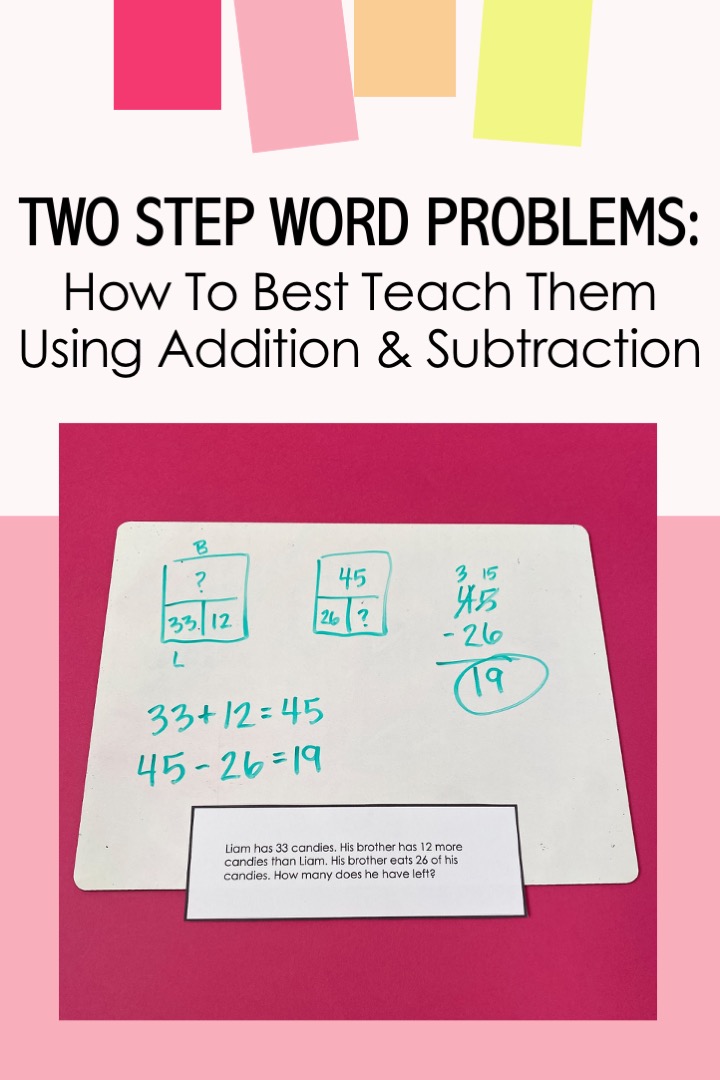
Here’s my approach for teaching two step word problems.
So today, I thought it would be super helpful to share my approach for teaching two step word problems, including what is a two step word problem, two step word problem examples, and the helpful two step word problems worksheets I have my students use.
If you’re a parent who has a child struggling with math, you’ve got to check out Learner. Learner is an online tutoring platform that sets students up for success. To get started take a short quiz about your child’s needs. Then Learner’s Success Management Team reviews that and matches your child with the perfect tutor. Get your $25 trial here.
So, let’s get started with what a two step word problem is.
What is a Two Step Word Problem
What is a two step word problem? It is a word problem where you need to use two operations to solve.
For 2nd grade, they are working with addition and subtraction. So these word problems could have them add and then subtract. They could have them subtract then add. These problems can even have them add and then add or subtract and then subtract.
Two step word problems fall underneath the common core state standard of 2.OA.A.1. This standard wants 2nd grade students to solve both one and two step word problems within 100. These problems can deal with putting together, taking apart, and comparing. They want students to use drawings, symbols, or diagrams to help them solve.
The “OA” in that standard title stands for “Operations & Algebraic Thinking.” I had my husband help me out by making some answer keys to the two step word problems worksheets I use in my class. While he was making those he told me, “Wow, this is like algebra.” I said to him that he was exactly right and that there was a whole list of algebraic thinking standards that 2nd grade students learn.
Two Step Word Problem Examples
Now that we know what a two step word problem is, let’s look at some two step word problem examples that 2nd grade students would see.
After teaching these word problems for years and years, I’ve noticed that there are 2 main types of two step word problems: story structure where you can know to add or subtract based on the sequence, and part-part-whole structure where you reason through and put numbers in a part-part-whole diagram to know if you should add or subtract.
Let’s look at examples of both of these types.
Story Structure:
“Ella has 9 pencils. She gives 4 pencils to her classmates. Then, her teacher gives her 3 more pencils. How many pencils does Ella have now?”
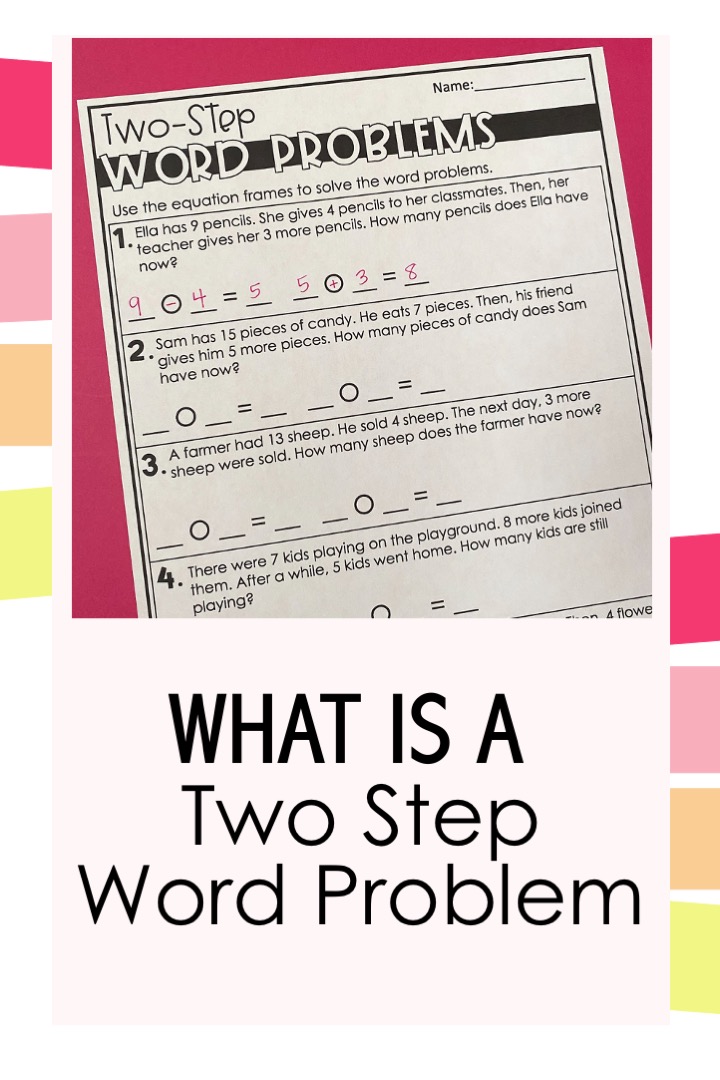
What is a two step word problem? It is just a word problem where you use two equations to solve.
To solve this one, we can just use the sequence of the story. How many pencils does Ella start with? 9. She gives away 4 pencils. If she is giving them away, is Ella getting more or less pencils? She is getting less so we subtract 4. That means our first equation is 9-4=5. Right now in the story she has 5 pencils. Then it says her teacher gives her 3 more pencils. If her teacher is giving her 3 more pencils, is Ella getting more pencils or less? She is getting more so we add for our 2nd equation. 5+3=8. How many pencils does Ella have now? She has 8 pencils.
Part-Part-Whole Structure:
“Sophia has 13 stamps. Emma has 34 more stamps than Sophia. How many stamps do they have together?”
The first part of this word problem uses comparison. It says Emma has 34 more stamps than Sophia. Emma doesn’t have 34 stamps. She has 34 MORE than Sophia. We do know that Sophia has 13 stamps. We can use a part-part-whole diagram to know if we should add or subtract.
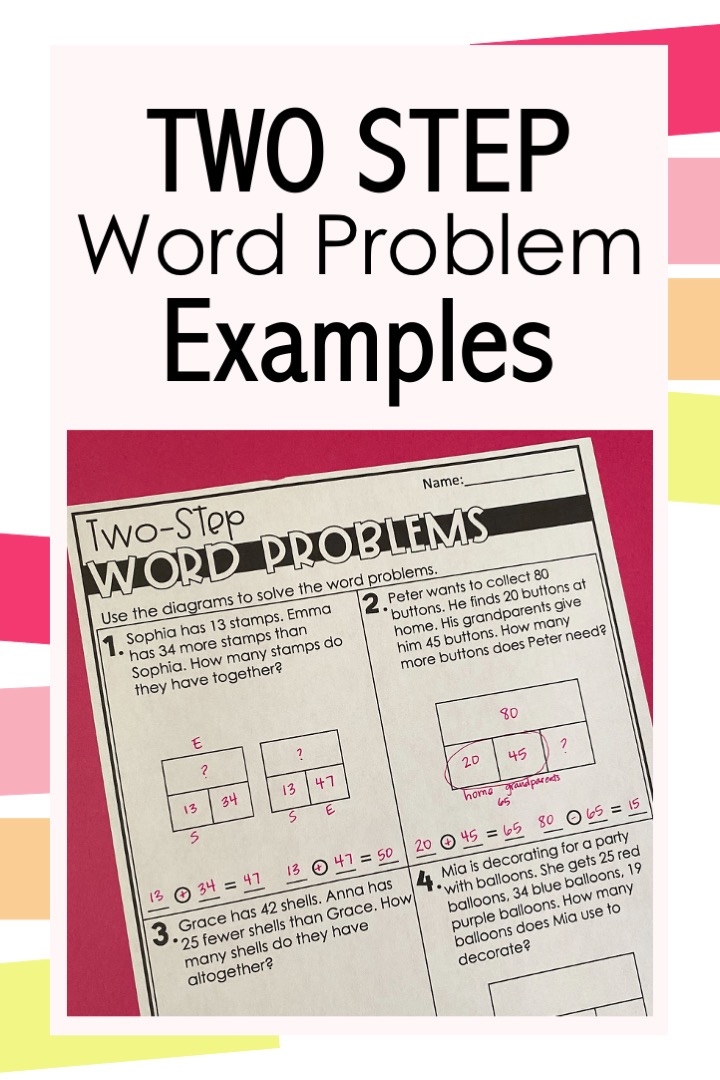
These two step word problem examples show the part-part-whole structure of these kinds of problems.
To do that, we first think about who has more. Does Sophia or Emma have more? Emma does. So she gets the long line of the “whole” in the part-part-whole diagram. Sophia has less so she gets a short line of a “part.” I like to label these with their initials. I put an “S” above the “whole.” and I put an “E” under a part.
Then we read the problem again and fill in the numbers. It says Sophia has 13 stamps. So we put 13 in Sophia’s “part.” The problem says that Emma has 34 more stamps than Sophia. Since that is not Emma’s number we put 34 in the other “part.”
In the diagram, we have 2 parts but not the whole. So we add. 13+34=57. That is how many stamps Emma has.
Then the next part of the problem asks how many stamps they have together. If we use another part-part-whole diagram, we don’t know how many they have together yet, so we don’t know the “whole.” That means we add the 2 parts, or add the number of Emma’s stamps and Sophia’s stamps. 13+57=70. They have 70 stamps together.
There is another part-part-whole structure of two step word problems that I like to show students. But this one is really a part-part-part-whole. Yes, you heard me right. The problems have 3 parts or 3 categories! Once we have the numbers filled in we can combine two of the parts to make it into a regular part-part-whole.
Let’s look at this structure with an example.
“Peter wants to collect 80 buttons. He finds 20 buttons at home. His grandparents give him 45 buttons. How many more buttons does Peter need?”
The three categories in this word problem are the buttons at home, the buttons his grandparents give him, and how many more Peter needs to get to his goal of 80. We put 80 in the whole, 20 in a part, 45 in another part, and a question mark in the last part.
Then we combine the two parts that we know. That means our first equation is 20+45=65. I like to put that 65 underneath those 2 parts to show that we combined that. Now we have a regular part-part-whole. We have the whole and a part, but not the other part, so we subtract. 80-65=15. Peter needs 15 more buttons.
Now that we know the different structures of two step word problems, let me share with you exactly how I teach these to my 2nd grade students.
But before we get into that, it’s important to note that students do best with two step word problems when they have already worked with one step word problems. Read my blog post about teaching these word problems here: 3 Math Word Problem Solving Strategies to Help Students Be Successful
How to Teach Two Step Word Problems
The best thing you can do when teaching two step word problems is to teach the 2 main structures that I mentioned before. We want students to be on the lookout for what kind of problems they are working on.
I use display pages to do this. I project these up on our whiteboard and use them as slides. They give me examples of each kind. I model solving a few and then have students help me.
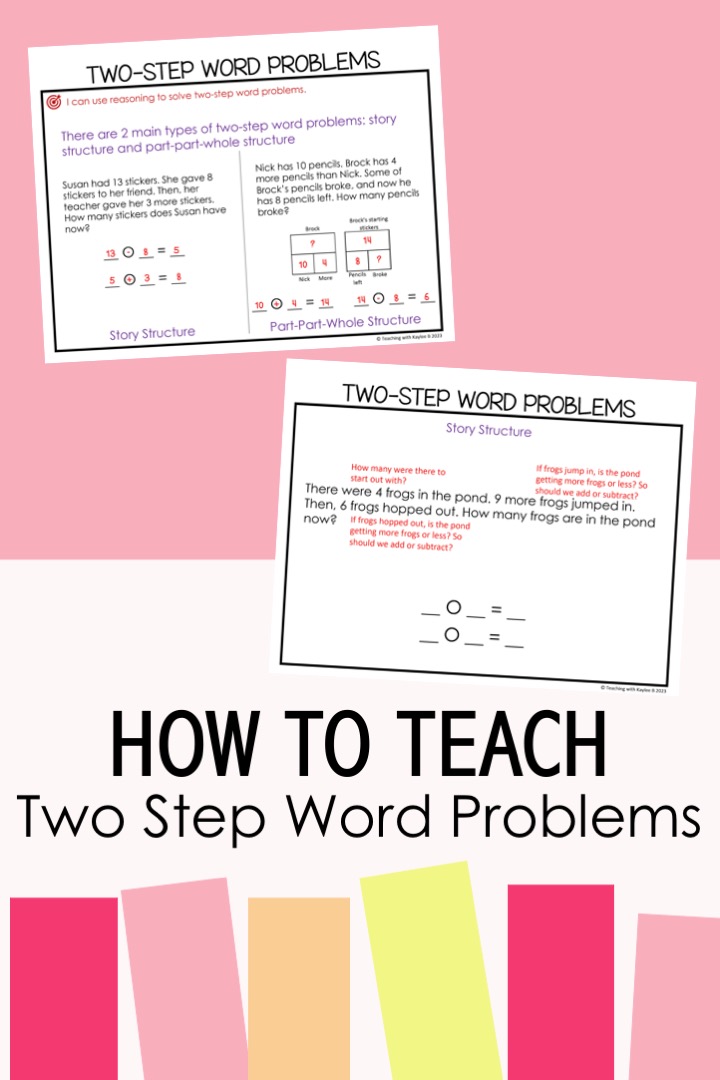
These display pages make it easy to teach two step word problems.
The display pages guide me on what to do and what to say. They make teaching two step word problems so easy!
I like to first introduce story structure problems because these problems have easier reasoning for students to work through. I give them a two step word problems worksheet. We do the first one on the page together. Then students complete the rest as I walk around helping students. I take note of common mistakes. Then I call students’ attention back. I go over those mistakes and have students fix their work.
I give them another worksheet that they complete by themselves. I wait over at our classroom table. When students finish their worksheet, they line up by me. I look over their work and help them fix any mistakes. When their work looks good, I draw a big check mark on their page with a smelly marker. It’s like a little reward for finishing because students love to see what the day’s scent is. Students then put their page in their Take Home Folder.
After that I like to give students even more practice with these kinds of word problems. I have them work with a partner to complete a scoot activity. This is where I have task cards taped up around my classroom. These have two step word problems on them. Students have a recording sheet and go around with their partner solving the problems. I like to have students work with a partner because they can support each other.
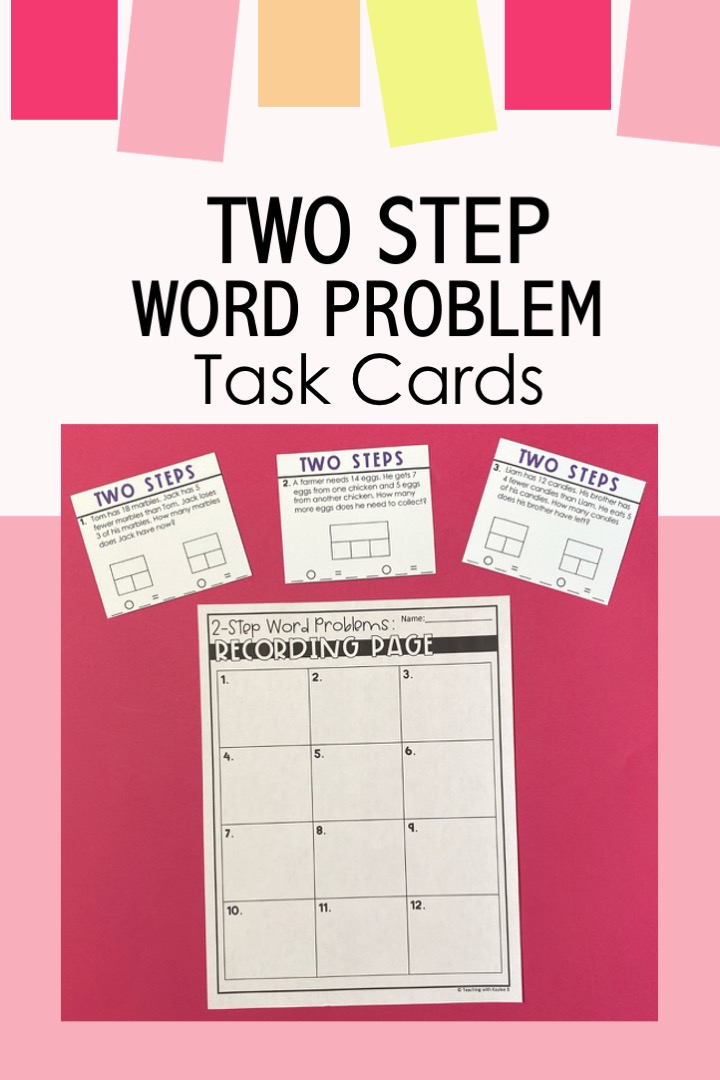
Help students get the practice they need with two step word problems with these task cards.
Once students complete this scoot activity, I have them check their work with an answer key I have set out. They use a red pen to fix their mistakes and then they can put their page in their Take Home Folder. I like to do this because students get immediate feedback. Parents also get to see how their child understood the lesson from the day without any extra work on my end.
Then to get students some fun hands-on practice, I have them complete a puzzle activity with that same partner. These are sheets of paper with two step word problems and students have to line up the equations that solve the problems. I love these because it gets students focusing on the reasoning they need to solve rather than focusing on the numbers.
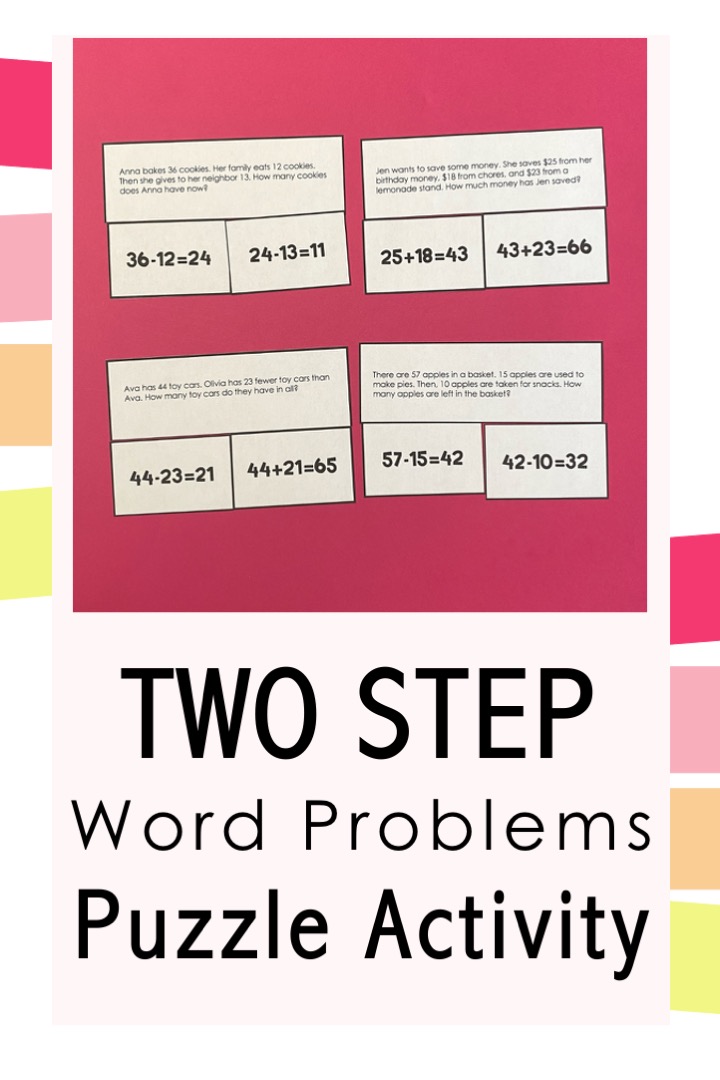
These puzzles are a fun way for students to practice two step word problems.
When students finish these, they raise their hands. I come over and do a quick check over their work. Then they mix up the pieces, stack them up, and they are ready for the next set of students.
And finally, I want to know exactly where students are at with solving these kinds of two step word problems, so I have them complete an exit ticket. This has students rate themselves on how they think they understood the lesson. Then it has them solve a couple problems. I check these after school and take note of students who could use a little extra practice after school.
The next day I have a similar lesson on two step word problems. But this time we focus on part-part-whole structured problems. I still use display pages, worksheets, a scoot activity, and a puzzle activity.
The day after that, I do a lesson with the same set up, but now students work on problems with a mix of both structures.
I have a resource that has all the materials I use for teaching two-step word problems. Find it here.
This resource has 6 different sets of materials. It breaks apart the different structures so that you can have the lessons I mentioned above. There are even sets using numbers 1-20 and sets using numbers 1-100. That way when you take note of what students need a little extra practice, you can have them work on problems with easier numbers. This helps them focus on the reasoning involved rather than the numbers involved.
Find all of these materials here.
Two Step Word Problems Worksheets
When I do see that students need a little extra help, I like to use scaffolded worksheets. The part-part-whole word problems are more difficult for students. To help students, I use worksheets that label the different parts of the diagram. This helps students reason through the word problem and plug in numbers where they need to go.
Once students do well with those, I move them onto two step word problem worksheets that still have the part-part-whole diagram but they are not labeled. Students can label these to help them reason through the problem.
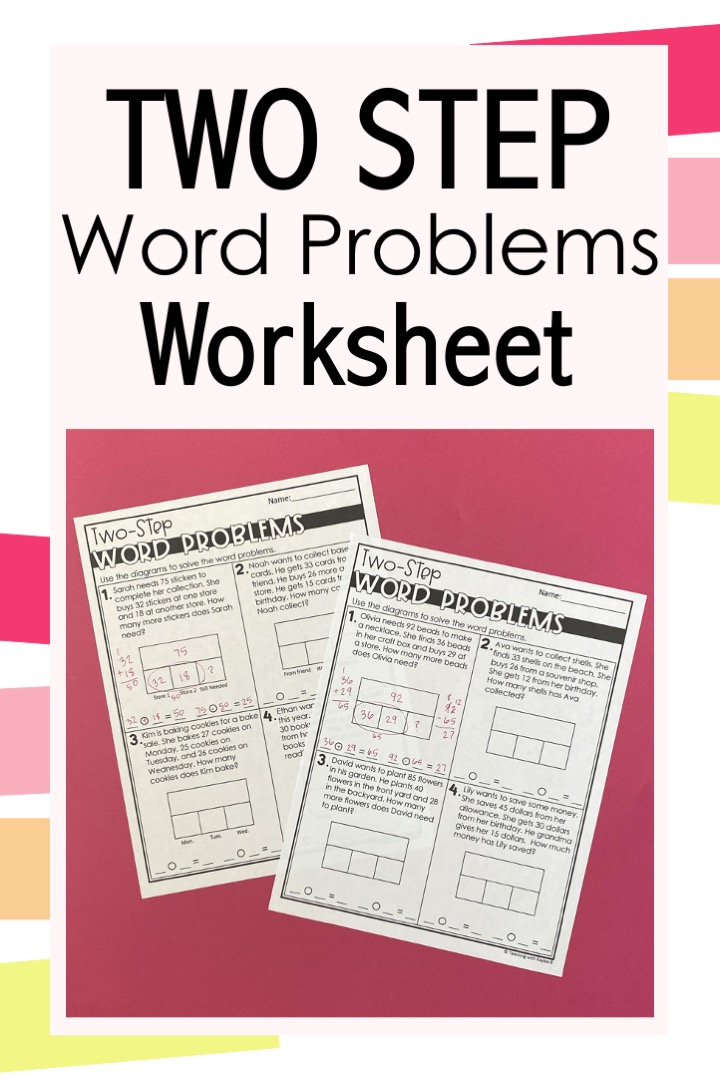
These two step word problems worksheets provide students the support they need when mastering these types of word problems.
After that, I have students do a worksheet where it’s just the problem. They have to draw the diagram and fill in the numbers to solve.
Can you see how these worksheets take away support one step at a time? By having students do these, even the students who struggle can find success. Find these two step word problem worksheets here.
I hope this blog post has brought clarity on what is a two step word problem and how to teach them. For me, it all comes down to teaching students the 2 main types and giving them scaffolded practice.
Find my one-step word problems resource here. I have a measurement word problem resource. Find it here. You can find my dollar bills word problems here.


